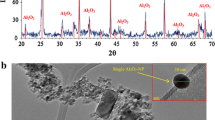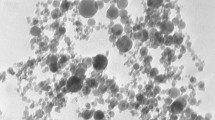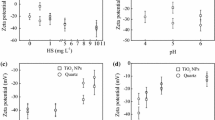Abstract
Alumina nanofluids are one of the most useful nanofluids, especially for increasing the thermal conductivity. Due to importance of porous media in the improvement of heat transfer, this study investigates the transport and retention of gamma alumina/water nanofluid in the water-saturated porous media. For this purpose, alumina nanofluids were introduced to the porous media consisting of water-saturated glass beads possessing various pH values (4, 7 and 10) and different ionic strengths (0.001 M of KCl, CaCl2, AlCl3, K2SO4, CaSO4, Al2(SO4)3, K2CO3 and CaCO3). Then the break through curve of each experiment was drawn and modeled by combining classical filtration theory with advection–dispersion equation. Single collector efficiency (η0) and attachment efficiency (α) were calculated by classical filtration theory. Also curve fitting of experiments and modeling was achieved by minimizing the sum of squared residuals, to calculate retardation factor (R) and hydrodynamic dispersion coefficient (D) of each experiment. According to the results, in general, increase in pH and ionic strength will enhance the removal rate coefficient, retardation factor and retention while decreasing the steady-state break through concentration and the hydrodynamic dispersion coefficient. The opposite of this rule was observed and analyzed for aluminum salts. The lowest retention of nanoparticles at 31.04% can be related to their transport in background solution with pH = 4 [α = \(3.87 \times 10^{ - 2}\), Katt = \(3.33 \times 10^{ - 3}\) (min−1), R = 3.93, D = 0.91 (cm2 min−1)], and the highest retention in nanoparticle content of 94.29% was observed in background solution containing CaCO3 [α = \(14.33 \times 10^{ - 2}\), Katt = \(137.82 \times 10^{ - 3}\) (min−1), R = 12.02, D = 0.62 (cm2 min−1)]. Therefore, chemistry of water plays an important role in transport and retention parameters. The classical filtration theory and the advection–dispersion model are able to perfectly model and quantify the parameters of the alumina nanofluid transport in saturated porous media.







Similar content being viewed by others
Abbreviations
- mass%:
-
Mass percentage
- \(C\) :
-
Concentration of nanoparticles (Kg m−3)
- \(C_{\text{e}}\) :
-
Steady-state concentration (Kg m−3)
- \(C_{0}\) :
-
Concentration in influent fluid (Kg m−3)
- \(C_{\text{eff}}\) :
-
Concentration in effluent fluid (Kg m−3)
- \(t\) :
-
Time (s)
- \(t_{\text{f}}\) :
-
Total time of injection (s)
- \(x\) :
-
Distance parallel to the flow (m)
- \(R\) :
-
Retardation factor
- \(k_{\text{att}}\) :
-
Deposition rate coefficient (s−1)
- \(D\) :
-
Dispersion coefficient (m2 s−1)
- \(K_{\text{d}}\) :
-
Partitioning coefficient (m3 Kg−1)
- \(L\) :
-
Length of porous media (m)
- \(M_{\text{rec}}\) :
-
Recovered mass of nanoparticles (Kg)
- \(M_{\text{i}}\) :
-
Total injected mass (Kg)
- \(Q\) :
-
Velocity (m s−1)
- \(\% R_{\text{rec}}\) :
-
Recovery percent of nanoparticles
- \(\% R_{\text{ret}}\) :
-
Retention percent of nanoparticles
- \(d_{\text{c}}\) :
-
Collector diameter (m)
- \(v\) :
-
Pore velocity (m s−1)
- θ :
-
Porosity
- \(\rho_{\text{b}}\) :
-
Bulk density (Kg m−3)
- \(\eta_{0}\) :
-
Single collector efficiency
- \(\eta_{\text{D}}\) :
-
Diffusion efficiency
- \(\eta_{\text{I}}\) :
-
Interception efficiency
- \(\eta_{\text{G}}\) :
-
Gravity efficiency
- \(\alpha\) :
-
Attachment efficiency
- PV:
-
Pore volume
- CFT:
-
Classical filtration theory
- ADE:
-
Advection–dispersion equation
- BTC:
-
Break through curve
- SSR:
-
Sum of squared residuals
References
Bashirnezhad K, Rashidi MM, Yang Z, Bazri S, Yan W-M. A comprehensive review of last experimental studies on thermal conductivity of nanofluids. J Therm Anal Calorim. 2015;122(2):863–84.
Rashidi S, Mahian O, Languri EM. Applications of nanofluids in condensing and evaporating systems. J Therm Anal Calorim. 2018;131(3):2027–39.
Shahsavani E, Afrand M, Kalbasi R. Experimental study on rheological behavior of water–ethylene glycol mixture in the presence of functionalized multi-walled carbon nanotubes: a novel correlation for the non-Newtonian nanofluid. J Therm Anal Calorim. 2018;131(2):1177–85.
Afrand M. Experimental study on thermal conductivity of ethylene glycol containing hybrid nano-additives and development of a new correlation. Appl Therm Eng. 2017;110:1111–9.
Hemmat Esfe M, Saedodin S, Mahian O, Wongwises S. Thermal conductivity of Al2O3/water nanofluids. J Therm Anal Calorim. 2014;117(2):675–81.
Bahiraei M, Mashaei PR. Using nanofluid as a smart suspension in cooling channels with discrete heat sources. J Therm Anal Calorim. 2015;119(3):2079–91.
Hemmat Esfe M, Rostamian H, Toghraie D, Yan W-M. Using artificial neural network to predict thermal conductivity of ethylene glycol with alumina nanoparticle. J Therm Anal Calorim. 2016;126(2):643–8.
Barbés B, et al. Thermal conductivity and specific heat capacity measurements of Al2O3 nanofluids. J Therm Anal Calorim. 2013;111(2):1615–25.
Moshizi SA, Malvandi A. Different modes of nanoparticle migration at mixed convection of Al2O3–water nanofluid inside a vertical microannulus in the presence of heat generation/absorption. J Therm Anal Calorim. 2016;126(3):1947–62.
Sekrani G, Poncet S, Proulx P. Conjugated heat transfer and entropy generation of Al2O3–water nanofluid flows over a heated wall-mounted obstacle. J Therm Anal Calorim. 2018. https://doi.org/10.1007/s10973-018-7349-x.
Mahian O, et al. Recent advances in modeling and simulation of nanofluid flows-part I: fundamentals and theory. Phys Rep. 2018. https://doi.org/10.1016/j.physrep.2018.11.004.
Mahian O, et al. Recent advances in modeling and simulation of nanofluid flows-part II: applications. Phys Rep. 2018. https://doi.org/10.1016/j.physrep.2018.11.003.
Khanafer K, Vafai K. Applications of nanofluids in porous medium. J Therm Anal Calorim. 2018. https://doi.org/10.1007/s10973-018-7565-4.
Mashaei PR, Shahryari M, Madani S. Numerical hydrothermal analysis of water–Al2O3 nanofluid forced convection in a narrow annulus filled by porous medium considering variable properties. J Therm Anal Calorim. 2016;126(2):891–904.
Alizadeh R, Karimi N, Arjmandzadeh R, Mehdizadeh A. Mixed convection and thermodynamic irreversibilities in MHD nanofluid stagnation-point flows over a cylinder embedded in porous media. J Therm Anal Calorim. 2018. https://doi.org/10.1007/s10973-018-7071-8.
Ibáñez G, López A, López I, Pantoja J, Moreira J, Lastres O. Optimization of MHD nanofluid flow in a vertical microchannel with a porous medium, nonlinear radiation heat flux, slip flow and convective–radiative boundary conditions. J Therm Anal Calorim. 2018.
Nowack B, Bucheli TD. Occurrence, behavior and effects of nanoparticles in the environment. Environ Pollut. 2007;150(1):5–22.
Sen TK. Processes in pathogenic biocolloidal contaminants transport in saturated and unsaturated porous media: a review. Water Air Soil Pollut. 2011;216(1):239–56.
Feighery J, Mailloux BJ, Ferguson AS, Ahmed KM, Geen A, Culligan PJ. Transport of E. coli in aquifer sediments of Bangladesh: implications for widespread microbial contamination of groundwater. Water Resour Res. 2013;49(7):3897–911.
Jiang W, Mashayekhi H, Xing B. Bacterial toxicity comparison between nano- and micro-scaled oxide particles. Environ Pollut. 2009;157(5):1619–25.
Sadiq IM, Pakrashi S, Chandrasekaran N, Mukherjee A. Studies on toxicity of aluminum oxide (Al2O3) nanoparticles to microalgae species: scenedesmus sp. and chlorella sp. J Nanoparticle Res. 2011;13(8):3287–99.
Li Z, Sahle-Demessie E, Hassan AA, Sorial GA. Transport and deposition of CeO2 nanoparticles in water-saturated porous media. Water Res. 2011;45(15):4409–18.
Li X, Scheibe TD, Johnson WP. Apparent decreases in colloid deposition rate coefficients with distance of transport under unfavorable deposition conditions: a general phenomenon. Environ Sci Technol. 2004;38(21):5616–25.
Li X, Johnson WP. Nonmonotonic variations in deposition rate coefficients of microspheres in porous media under unfavorable deposition conditions. Environ Sci Technol. 2005;39(6):1658–65.
Ryan JN, Elimelech M. Colloid mobilization and transport in groundwater. Colloids Surf A Physicochem Eng Asp. 1996;107:1–56.
Yao K-M, Habibian MT, O’Melia CR. Water and waste water filtration. Concepts and applications. Environ Sci Technol. 1971;5(11):1105–12.
Clark MM. Transport modeling for environmental engineers and scientists. Hoboken: Wiley; 2011.
Rodier E, Dodds J. An experimental study of the transport and capture of colloids in porous media by a chromatographic technique. Colloids Surf A Physicochem Eng Asp. 1993;73:77–87.
Saleh N, et al. Surface modifications enhance nanoiron transport and NAPL targeting in saturated porous media. Environ Eng Sci. 2006;24(1):45–57.
Lecoanet HF, Bottero J-Y, Wiesner MR. Laboratory assessment of the mobility of nanomaterials in porous media. Environ Sci Technol. 2004;38(19):5164–9.
Jaisi DP, Saleh NB, Blake RE, Elimelech M. Transport of single-walled carbon nanotubes in porous media: filtration mechanisms and reversibility. Environ Sci Technol. 2008;42(22):8317–23.
Han B, Liu W, Zhao X, Cai Z, Zhao D. Transport of multi-walled carbon nanotubes stabilized by carboxymethyl cellulose and starch in saturated porous media: influences of electrolyte, clay and humic acid. Sci Total Environ. 2017;599–600:188–97.
Chowdhury I, Hong Y, Honda RJ, Walker SL. Mechanisms of TiO2 nanoparticle transport in porous media: role of solution chemistry, nanoparticle concentration, and flowrate. J Colloid Interface Sci. 2011;360(2):548–55.
Godinez IG, Darnault CJG. Aggregation and transport of nano-TiO2 in saturated porous media: effects of pH, surfactants and flow velocity. Water Res. 2011;45(2):839–51.
Godinez IG, Darnault CJG, Khodadoust AP, Bogdan D. Deposition and release kinetics of nano-TiO2 in saturated porous media: effects of solution ionic strength and surfactants. Environ Pollut. 2013;174:106–13.
Fang J, Xu M, Wang D, Wen B, Han J. Modeling the transport of TiO2 nanoparticle aggregates in saturated and unsaturated granular media: effects of ionic strength and pH. Water Res. 2013;47(3):1399–408.
Kasel D, Bradford SA, Šimůnek J, Heggen M, Vereecken H, Klumpp E. Transport and retention of multi-walled carbon nanotubes in saturated porous media: effects of input concentration and grain size. Water Res. 2013;47(2):933–44.
Wang Y, Li Y, Fortner JD, Hughes JB, Abriola LM, Pennell KD. Transport and retention of nanoscale C60 aggregates in water-saturated porous media. Environ Sci Technol. 2008;42(10):3588–94.
Li Y, Wang Y, Pennell KD, Abriola LM. Investigation of the transport and deposition of fullerene (C60) nanoparticles in quartz sands under varying flow conditions. Environ Sci Technol. 2008;42(19):7174–80.
Hu Z, Zhao J, Gao H, Nourafkan E, Wen D. Transport and deposition of carbon nanoparticles in saturated porous media. Energies. 2017;10(8):1151–67.
Jiang X, Tong M, Lu R, Kim H. Transport and deposition of ZnO nanoparticles in saturated porous media. Colloids Surf A Physicochem Eng Asp. 2012;401:29–37.
Kamrani S, Rezaei M, Kord M, Baalousha M. Transport and retention of carbon dots (CDs) in saturated and unsaturated porous media: role of ionic strength, pH, and collector grain size. Water Res. 2018;133:338–47.
Rahman T, George J, Shipley HJ. Transport of aluminum oxide nanoparticles in saturated sand: effects of ionic strength, flow rate, and nanoparticle concentration. Sci Total Environ. 2013;463–464:565–71.
Rahman T, Millwater H, Shipley HJ. Modeling and sensitivity analysis on the transport of aluminum oxide nanoparticles in saturated sand: effects of ionic strength, flow rate, and nanoparticle concentration. Sci Total Environ. 2014;499:402–12.
Davoudi A, Salehpour A, Habibi A. Transport and deposition of alumina nanoparticles in water saturated porous media: an experimental study. J Dispers Sci Technol. 2014;35(9):1339–44.
Bayat AE, Junin R, Shamshirband S, Chong WT. Transport and retention of engineered Al2O3, TiO2, and SiO2 nanoparticles through various sedimentary rocks. Sci Rep. 2015;5:14264.
Li Y, Zhou J, Tung S, Schneider E, Xi S. A review on development of nanofluid preparation and characterization. Powder Technol. 2009;196(2):89–101.
Shin JY, O’Melia CR. Pretreatment chemistry for dual media filtration: model simulations and experimental studies. Water Sci Technol. 2006;53(7):167–75.
Huang H, Spinette R, O’Melia CR. Direct-flow microfiltration of aquasols: I. Impacts of particle stabilities and size. J Memb Sci. 2008;314(1):90–100.
Huang H, O’Melia CR. Direct-flow microfiltration of aquasols: II. On the role of colloidal natural organic matter. J Memb Sci. 2008;325(2):903–13.
Hahn MW, Abadzic D, O’Melia CR. Aquasols: on the role of secondary minima. Environ Sci Technol. 2004;38(22):5915–24.
Tufenkji N, Redman JA, Elimelech M. Interpreting deposition patterns of microbial particles in laboratory-scale column experiments. Environ Sci Technol. 2003;37(3):616–23.
Tufenkji N, Elimelech M. Correlation equation for predicting single-collector efficiency in physicochemical filtration in saturated porous media. Environ Sci Technol. 2004;38(2):529–36.
Parker JC, Vangenuchten MT. Determining transport parameters from laboratory and field tracer experiments, no. 84–3. Blacksburg: Bulletin; 1984.
Tufenkji N. Modeling microbial transport in porous media: traditional approaches and recent developments. Adv Water Resour. 2007;30(6):1455–69.
Jung Y, Tien C. Increase in collector efficiency due to deposition in polydispersed granular filtration: an experimental study. J Aerosol Sci. 1992;23(5):525–37.
de Jonge LW, Kjaergaard C, Moldrup P. Colloids and colloid-facilitated transport of contaminants in soils. Vadose Zone J. 2004;3:321–5.
Jung Y, Tien C. New correlations for predicting the effect of deposition on collection efficiency and pressure drop in granular filtration. J Aerosol Sci. 1991;22(2):187–200.
Johnson PR, Elimelech M. Dynamics of colloid deposition in porous media: blocking based on random sequential adsorption. Langmuir. 1995;11(3):801–12.
Liu D, Johnson PR, Elimelech M. Colloid deposition dynamics in flow-through porous media: role of electrolyte concentration. Environ Sci Technol. 1995;29(12):2963–73.
Rajagopalan R, Chu RQ. Dynamics of adsorption of colloidal particles in packed beds. J Colloid Interface Sci. 1982;86(2):299–317.
Vaidyanathan R, Tien C. Hydrosol deposition in granular media under unfavorable surface conditions. Chem Eng Sci. 1991;46(4):967–83.
Ryde N, Kallay N, Matijević E. Particle adhesion in model systems. Part 14: experimental evaluation of multilayer deposition. J Chem Soc Faraday Trans. 1991;87(9):1377–81.
Zhang P, Fan C, Lu H, Kan AT, Tomson MB. Synthesis of crystalline-phase silica-based calcium phosphonate nanomaterials and their transport in carbonate and sandstone porous media. Ind Eng Chem Res. 2011;50(4):1819–30.
Zareei M, Yoozbashizadeh H, Madaah Hosseini HR. Investigating the effects of pH, surfactant and ionic strength on the stability of alumina/water nanofluids using DLVO theory. J Therm Anal Calorim. 2018. https://doi.org/10.1007/s10973-018-7620-1.
He F, Zhang M, Qian T, Zhao D. Transport of carboxymethyl cellulose stabilized iron nanoparticles in porous media: column experiments and modeling. J Colloid Interface Sci. 2009;334(1):96–102.
Jin Y, Yates MV, Thompson SS, Jury WA. Sorption of viruses during flow through saturated sand columns. Environ Sci Technol. 1997;31(2):548–55.
He F, Zhao D, Liu J, Roberts CB. Stabilization of Fe–Pd nanoparticles with sodium carboxymethyl cellulose for enhanced transport and dechlorination of trichloroethylene in soil and groundwater. Ind Eng Chem Res. 2007;46(1):29–34.
Regression L, Fitting C. Linear regression and curve fitting. Excel for Chemists®, p. 435–62, 01 Nov 2011.
Amirtharajah A. Some theoretical and conceptual views of filtration. J Am Water Works Assoc. 1988;80(12):36–46.
Donose BC, Nguyen AV, Evans GM, Yan Y. Effect of aluminium sulphate on interactions between silica surfaces studied by atomic force microscopy. Water Res. 2007;41(15):3449–57.
Takahashi Y, Minai Y, Ambe S, Makide Y, Ambe F. Comparison of adsorption behavior of multiple inorganic ions on kaolinite and silica in the presence of humic acid using the multitracer technique. Geochim Cosmochim Acta. 1999;63(6):815–36.
Author information
Authors and Affiliations
Corresponding author
Additional information
Publisher's Note
Springer Nature remains neutral with regard to jurisdictional claims in published maps and institutional affiliations.
Rights and permissions
About this article
Cite this article
Zareei, M., Yoozbashizadeh, H. & Madaah Hosseini, H.R. The effect of pH and ionic strength on the transport of alumina nanofluids in water-saturated porous media. J Therm Anal Calorim 137, 1169–1179 (2019). https://doi.org/10.1007/s10973-018-08002-w
Received:
Accepted:
Published:
Issue Date:
DOI: https://doi.org/10.1007/s10973-018-08002-w




